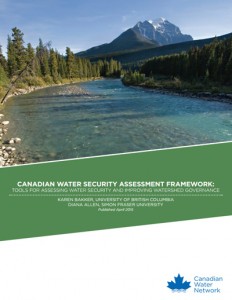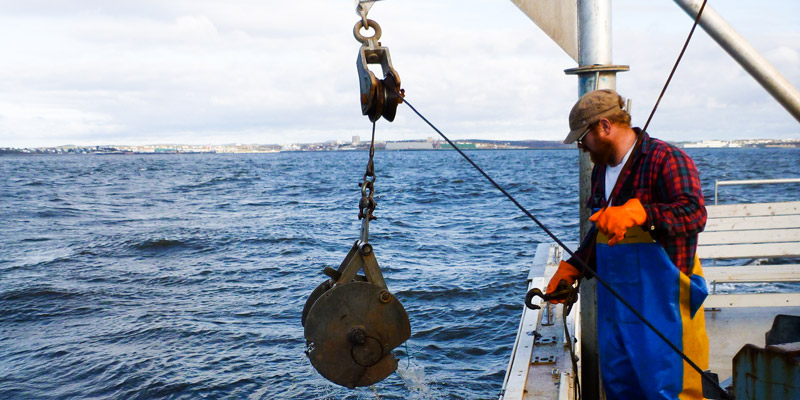Developing a Canadian Water Security Framework as a Tool for Assessing Cumulative Impacts and Improving Watershed Governance
Principal Investigator - Karen Bakker, Associate Professor, University of British Columbia, 2008 - 2012

Challenge
Water security is an emerging concept that has gained increasing attention over the past five years. Spread across a wide range of disciplines, the term has been defined and measured at varying scales. As such, no common definition of water security exists. Similarly, while several water-related indices have been developed in Canada to improve water security, no widely accepted, standardized index exists. Current indices tend to focus too narrowly, which makes it difficult for decision‐makers to assess and mediate conflicting water use demands. This can have significant risks. For example, the inability to minimize adverse affects from land and water management practices could affect watershed integrity and public health, both of which can be costly to mitigate.
The goal of the research project was to improve water security in Canada by enhancing governance for source protection and land use through the generation of an integrative definition of water security and the development of a comprehensive water security framework.
Project
The research project created an indicator-based water security assessment method that integrates the assessment of both water quality and quantity, as they relate to human and ecosystem health. By assessing water security status in combination with risk assessments, and incorporating this into an adaptive governance framework, the research team produced a flexible “learning by doing” approach that is capable of responding to changing conditions.
Built on existing indices and data from team partners and researchers, the water security framework integrated several different types of models, including a land-use allocation model and water vulnerability model. Meanwhile, the water security index was designed as a user-friendly index that makes use of the following types of data: water resources, ecosystem water quality, infrastructure, human health and governance capacity. This quantitative measure of water security allows for inter-watershed variations to be depicted. Spatial variation is captured by the supporting decision tools, which include a governance checklist and a GIS-based visualization tool. All of which led to the development of a method that differs from other Canadian water-related indices in its comprehensiveness and integration, its sensitivity to spatial variation in water security, and its inclusion of decision-support tools.
The project team found that assessment of current water security status needs to be combined with assessment of risks, and results incorporated into adaptive governance framework, which formalizes a flexible ‘learning by doing’ approach that can respond to changing conditions. The concept of water security was found to be worthy for consideration for both research and policy strategies in support of sustainable water governance.
Outputs
The main project outputs were five decision-support tools specifically developed for small communities, municipal water managers and provincial agencies to assess risk to water security in their watershed:
- Water Security Risk Assessment Framework
- Water Security Status Indicators
- Methodology for mapping the likelihood of groundwater contamination
- Water Security Risk Scoring method
- Boil Water Advisory Protocol
The team hosted a workshop in the final year of the project to disseminate results to and discuss results with international experts, partners and team members.
In addition, the research team produced 16 published peer reviewed articles (of which, the top papers are listed below), 5 Policy Reports, and 39 presentations.
Dunn, G., Bakker, K. (2009) “Canadian Approaches to Assessing Water Security: An Inventory of Indicators.”
Norman, E., Bakker, K., Dunn, G., Allen, D., Cook, C. (2010) “Water Security a Primer.”
Cook, C., and Bakker, K. (2012). “Water Security: Debating an emerging paradigm.” Global Environmental Change, 22(1): 94-102.
Teschke et al. (2010). “Water and sewage systems, socio-demographics, and duration of residence associated with endemic intestinal infectious diseases: A cohort study.” BMC Public Health, 10:767.
Outcomes
- Identification of important gaps related to data access and coordination, as well as scale. It also highlighted the value in undertaking water security assessments as a means to raise awareness and identify priorities in relation to water governance
- The summarized findings from the water security index has made it easier to clearly transmit information to community decision-makers, which has been helpful in leveraging community support
- Having the risk framework in GIS format allows the tool to be readily modified to incorporate more detailed hazard data. This tool can be used to highlight areas of the aquifer potentially at high risk of contamination, so that steps can be taken to mitigate those risks.
- Improved decision-making related to the development of the decision-support tools.
In addition, the research results have been read and discussed by key federal organizations (e.g. Canadian Council of Ministers of the Environment, WADC, National Round Table on Environment and the Economy, Environment Canada), which could influence future policy outcomes. For example, changes in the methodology demonstrating the impacts of gravel extraction pits are expected, as the current procedures tend to ignore the cumulative nature of the impacts.





